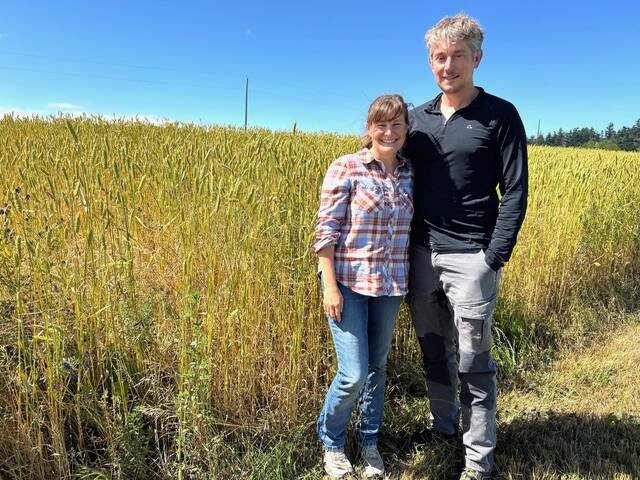Flour has been made by humans since the beginning of time by grinding wheat with a stone into a powder that can then be used to make bread. The process is little changed but today’s industrialized process and giant stones are much different. Most of us don’t think much about all that as we buy our five-pound bags of flour at the grocery store.
But now, on our Rock, hundreds of pounds of flour is being milled every week in a version of that industrialized process by the Bishop family, from wheat grown on their historic Ebey Road Farm on Ebey’s Prairie. Then that flour is used to make bread by the Little Red Hen Bakery in Coupeville and pizza dough used at Goldie’s Restaurant, also in Coupeville.
Clark Bishop, a fifth generation member of the family that founded Ebey Road Farm nearly 140 years ago, and his wife Danielle decided to try the flour business after Tyler Hansen, owner of Little Red Hen and co-owner of Goldie’s, started buying the heritage Red Russian wheat they grow more than eight years ago and taking it off island to be processed into flour. Hansen wants the bread products he bakes here to be made with wheat grown on Whidbey.
“So we decided to see what it would take for us to make flour for Tyler here,” Danielle said.
Clark and Hansen started looking around for a flour mill to buy. They contacted Breadlab, a program offered by Washington State University that works to create new regionally acclimated grains. For more than 15 years, the Bishops had offered several organic acres on their farm to Breadlab for its effort to create new grain varieties.
Breadlab introduced Clark and Danielle to Andrew Heyn, owner of New American Stone Mill in Vermont. The company owns a granite quarry from which it produces the big stones for flour mills. In 2023, they bought one of Heyn’s flour mills, had it shipped all the way across the country and installed it in a building on their farm. Flour mills are basically one giant granite stone wheel that grinds the wheat to flour. “We invited Andrew and his family to visit us after we installed the mill and he helped us make it work better,” Danielle said.
These days they are producing up to 1,000 pounds of flour a week during the busy tourist season on Whidbey. They have 20 acres planted in wheat, mostly Red Russian, a winter variety. They also grow some barley and a lot of hay for horses and livestock.
Hansen is their only customer for flour; his bakery makes seven or more bread varieties and it also produces the pizza dough for Goldie’s. The flour they produce for Little Red Hen consists of 30% from the Red Russian wheat grown on their farm and the rest from other varieties Hansen has selected that’s grown in or around Burlington.
Interestingly, Clark and Danielle are not the first members of their family to grow heritage Red Russian wheat on their farm. About 120 years ago, John LeSourd, son of Francis LeSourd who founded the farm in 1886, began growing Red Russian wheat. He sold some as feed for livestock, mostly poultry, and had some made into flour by other local farmers who had small grinding stones on their property. He also exported some of his wheat from the Coupeville Wharf by boat to Seattle and elsewhere, where it could be milled.
“John was born in Indiana and came here when he was just 10 years old. He was actually the farmer in the family and one year he won second place in a national yield competition. His father became a local politician and economic leader,” Danielle said. “Breadlab helped us figure out that he was growing Red Russian and that was a reason we wanted to grow it too.”
Clark is well aware that the flour business he and Danielle have begun requires a customer who understands what you are doing.
“Tyler came in and understood that this could not just be one 50-pound bag of wheat berries to be milled. It needs much more quantity and it took a year to get this going and ready to produce,” he said. “With grain as opposed to vegetables you really have to grow a lot to make it worthwhile.”
And, in August, they will harvest this year’s crop of Red Russian wheat. Although it’s a winter variety, it takes until mid-summer to be ready to harvest. Then for the next year that harvest will produce the flour that Tyler and his team will turn into the bread and pizza dough we Rock dwellers have come to love so well.
Harry Anderson is a retired journalist who worked for the Los Angeles Times and now lives on Central Whidbey.



